I. THEORIES OF DISTILLATION
Essential,
volatile or ethereal oils are mixtures composed of volatile, liquid and solid
compounds which vary widely in regard to their composition and boiling points.
Every substance with a determinable boiling point is volatile and possesses a
definite vapor pressure, which depends upon the prevailing temperature, and
which is very low in the case of very high boiling substances. Hence, the
intensity of an odor may be considered, to a certain extent and with many
exceptions, as a manifestation of the volatility (boiling point and vapor
pressure) of the substance which emits the odor.
Distillation may
be defined as "the separation of the components of a mixture of two or
more liquids by virtue of the difference in their vapor pressure" (Stephen
Miall, "A New Dictionary of Chemistry/' London, Longmans Green, 1940). The
process of distillation is obviously of considerable importance to the
essential oil producer. There are two general types to be considered :
1. Distillation of
mixtures of liquids which are not miscible, and hence form two phases.
Practically, this applies to the rectification and fractionation of essential
oils with steam, and, what is much more important, to the isolation of volatile
oils from aromatic plants with steam. Distillation with steam may also be
called hydrodistillation, which general term implies that distillation may be
carried out either by boiling the plant material or the essential oil with
water, and creating the necessary steam within the still, or by introducing
into the retort live steam generated hi a separate steam boiler.
2. Distillation of
liquids which are completely miscible in each/ other, and therefore form only
one phase. Practically, this applies to the rectification and separation of an
essential oil into several fractions (fractionation)," without the use of
steam.
The difference
between the behavior of single-phase mixtures and twophase mixtures can best be
understood by considering what happens when a liquid vaporizes, especially on
boiling. Let us consider first the case of a pure liquid in a closed container.
At a given, fixed temperature, the average energy of the molecules is fixed.
The molecules are in constant and completely random motion. Any molecule in the
main body of the liquid can travel only a short distance before it comes under
the influence of other molecules at which moment its direction of motion is
changed. Any molecule in the surface layer, however, which happens to be moving
in a direction away from the main body of the liquid can escape into the space
above the liquid, thus becoming a vapor molecule. Now, the vapor molecules,
too, are in constant motion, the speed of the molecules of any kind being
determined solely by the prevailing temperature. Any vapor molecule hitting the
liquid surface has a chance of being captured by the liquid in other words of
being reliquefied (condensed). As the temperature is raised the number of vapor
molecules increases. Obviously the chances of a molecule returning into the
liquid also increase, so that after a short time the number of molecules
vaporizing in a unit of time exactly equals the number condensing (being
reliquefied) in the same time. Thus, there arises a condition of dynamic
equilibrium, with the total number of molecules in the vapor state remaining
constant. If the space filled with saturated vapors is opened, vapor escapes
and will be replaced by the same number of molecules, i.e., by the same quantity
of vapor newly developed from the liquid mass. This applies not only to liquids
but to solids, because, as pointed out above, every substance with a
determinable boiling point is volatile.
Let us now suppose
that, still at constant temperature, a second liquid, completely miscible with
the first one, is added. Since the two liquids form a single phase, the surface
of the liquid mixture consists only partially of molecules of the first kind.
The number of molecules of the first kind escaping into the vapor space per
unit time must certainly depend on the number present in the surface layer, and
will, therefore, be smaller now than it was for the pure liquid. However, the
molecules being completely miscible, the total number returning from the vapor
to the liquid will not immediately be changed. Since the total amount of
surface is unchanged and since now more molecules of the first kind are
condensing than are being vaporized, temporarily the equilibrium originally
established will be disturbed. This process continues until a new equilibrium
is established, when these rates again become equal, and this in turn causes a
decrease in the number of molecules of the first kind present in the vapor
phase at any one time. Exactly the same law applies to the second component of
the mixture. In general, the number of molecules of any component of a homogeneous
mixture present in the vapor phase will thus be smaller than the number present
in the same vapor space if the pure liquid is involved. The fraction of the surface
occupied by either liquid is, of course, proportional to its relative amount,
and consequently the extent to which the rate of vaporization decreases will
depend on the composition of the liquid. The vapor composition of a one phase
mixture will, therefore, be determined at any fixed temperature by the
composition of the liquid.
Boiling point may be defined as "the
temperature at which, under atmospheric or any other specified pressure, a
liquid is transformed into a vapor; i.e., the temperature at which the vapor
pressure of the liquid equals the pressure of the surrounding gas or
vapor" ("Hackh's Chemical Dictionary/' Philadelphia, 1944). When
distilling at atmospheric pressure, this vapor pressure corresponds to the
weight of a mercury column of 760 mm.2 in height. Any reduction of
the pressure above a liquid causes a lowering of the boiling point, any
increase of pressure results in a higher boiling point. A liquid consisting of
several constituents, completely miscible in one another and possessing
different boiling points, in most cases (except the so-called "constant
boiling mixtures") does not have a uniform boiling point but a boiling
range. As the lower boiling constituents vaporize or distill off, the boiling
temperature of the liquid rises and finally approaches that of the highest
boiling constituent.
Next, let us consider the effect of adding to
a pure liquid in equilibrium with its vapor a second liquid which is completely
immiscible with the first one. This brings us to a discussion of the
distillation of heterogeneous liquids, as in the case of essential oil
distillation with steam or boiling water (hydrodistillation). To facilitate
visualization, imagine that the two media are kept well stirred, so that the
percentage of each liquid present remains the same in all parts of the mixture,
including the surface. Such mixing has little effect on the ultimate result.
Again, the rate of vaporization decreases, because the number of molecules of
the first liquid in the surface layer is decreased. In this case, however, the
liquids are not miscible, and the vapor molecules can only be condensed when
they strike a molecule of their own kind, so that the rate of condensation will
also be decreased. Now, the rate of vaporization and the rate of condensation
both depend upon the percentage of molecules of the first kind present on the
surface. These rates will be affected equally, and there will be no change in
the number of vapor molecules of the first component present. Applying the same
reasoning to the case of the other component leads to the same conclusion. We thus
arrive at the important law that the total number of molecules present in the
vapor space above a two-phase liquid mixture at ary gwtn temperature is equal
to the sum of the numbers of molecules so present if either liquid were dealt with
alone. Furthermore, since the relative amounts of the two liquids present have
not in any way entered our reasoning, this conclusion must be true regardless
of the relative amounts so long as both liquids are present.
---------
2
Equals 29.922
in.; or a
pressure of 14.6974 Ib. per sq. in. 1.0333 kg. per sq. cm.
In other words, in the case of a two-phase
(heterogeneous) liquid the composition of the mixed vapor, at a given
temperature, does not depend upon the composition of the liquid.
A system of water and essential oil forms a
two-phase liquid; therefore, this type of distillation is of primary importance
to the essential oil producer. Let us then consider further the results of the
above reasoning for our case. The pressure exerted by a vapor, whether it
consists of one or several kinds of molecules, is a manifestation of the
constant bombardment by the rapidly moving vapor molecules hitting the walls
enclosing the vapor. Pressure measures a force acting on a unit area, and this
force, in the case of a vapor, results from the vapor molecules striking the
wall and rebounding. The total pressure exerted will be equal to the pressure
expended by one molecule multiplied by the number of molecules hitting a unit
area of the wall in a unit of time. The kinetic energy expended by one molecule
will depend on the temperature, but the number of collisions with the wall will
depend on the number of molecules, of whatever kind, present in the vapor
space. In other words, the pressure will depend on the concentration of the
molecules or, stated differently, on the concentration of the vapor.
Now, it has been shown that in the case of a
two-phase liquid the total number of molecules present in the vapor phase in
equilibrium with it is greater than the number which would be present if either
pure liquid were present alone at the same temperature. Hence, the pressure
exerted by the vapor mixture will be greater than that exerted by either pure
vapor alone. In the distillation of volatile oils with steam or boiling water
(hydrodistillation), the pressure in the vapor space is maintained constant,
either by connecting the vapor space with the atmosphere or by suitable
controls to maintain a reduced or elevated pressure. For definiteness we shall
consider an operation at atmospheric pressure. If pure water is heated in a
still, it will begin to boil (or in other words, the pressure of its vapor will
equal that of the atmosphere), when its temperature has reached 1000C.
(212 0F.). Let us suppose that an oil insoluble in water is
introduced into the still along with the water. If permitted to do so, the
pressure in the vapor space would increase as previously shown. But in our case
the vapor space is connected to the atmosphere; therefore, the pressure will be
reduced to atmospheric pressure, which can be accomplished only by automatic
lowering of the temperature. When the temperature of a liquid is lowered, the tendency
of the liquid molecules to go into the vapor phase also decreases, thus
decreasing the concentration of the molecules in the vapor, and consequently the
vapor pressure. Hence, the temperature will be lowered to a value such that the
total pressure exerted by the vapor mixture is again equal to the operating
pressure (atmospheric pressure in our case). Thus the boiling temperature for
any two-phase liquid will always be lower than the boiling point of either of
the pure liquids at ike same total pressure. For example, water (boiling at 1000)
and benzene (boiling at 800) present two such insoluble liquids :
when a mixture of the two is brought to a boil at atmospheric pressure (760
mm.), it vaporizes (distills) constantly at 690 so long as both
constituents remain present in the liquid mixture. The moment either of the two
constituents is completely vaporized (distilled off), the temperature rises to
the boiling point of the remaining constituent. Such conditions prevail with
all volatile substances, provided they are insoluble in water or only very
slightly soluble, and are not chemically reacted upon by water. When brought to
boiling together with water, they vaporize at a temperature below that of
boiling water and also below those of the boiling points of the pure compounds
insoluble in water.
In the preceding discussion we emphasized
repeatedly that the vapor in equilibrium with a two-phase liquid consists of
two kinds of molecules. The total pressure exerted by such a mixture is due,
therefore, to the sum of the pressures of each kind of molecule alone. The
pressure exerted by either of the pure vapors at the same temperature would be
the vapor pressure of that pure component, while the total vapor pressure of
the mixture is thus equal to the sum of the partial vapor pressures. By partial
pressure we mean the vapor pressure of any one component in a mixed vapor.
Obviously for such two-phase liquid systems the partial pressure and vapor pressure
of any component are the same. This simple rule of the additivity of partial
pressures affords a ready means of estimating the temperature at which any
particular steam distillation (hydrodistillation) will occur. The vapor
pressures of the two pure components are simply tabulated at a series of
temperatures. The operating' temperature will then be that temperature at which
the sum of the two vapor pressures equals the operating pressure, in the above
cited example the atmospheric pressure. In that case, the vapor pressure of
water at 690 is 225 mm., the vapor pressure of benzene 535 mm.,
added together 760 mm. This condition permits the combined vapors of the
constituents to overcome the (normal) atmospheric pressure; in other words, the
mixture starts to boil at 690 under normal atmospheric pressure. In
order to effect the boiling of a volatile compound insoluble in water, it remains
immaterial whether the substance in question is brought to a boil with water or
whether live steam is injected into the liquid or finely powdered substance. It
is the steam (water vapors whence the term hydrodistillation) that causes the
boiling (distillation, in our case) of the compound insoluble in water, at a
'emperature below the boiling point of the compound itself and below that of
water.
The composition of the vapor formed from a
two-phase liquid mixture depends on the partial vapor pressures of the pure
constituents. Thus, if the vapor pressure of component A is high and that of B
low, the mixed vapor will consist very largely of component A . The ratio between the weights of component A
and B will be given by the ratio of their vapor pressures multiplied by the
ratio of their molecular weights. As pointed out, boiling will take place
only when the sum of the partial pressures exerted by the components is equal
to the pressure maintained in the vapor space ; therefore, a heterogeneous (two-phase)
liquid boils or distills at a temperature which, at the same total pressure,
always lies below the boiling point of the lowest boiling constituent, so long
as the latter remains in the mixture, pt is for this reason primarily that
hydrodistillation has been used for such a long time and so generally in the
isolation of essential oils from aromatic plants. By vaporizing (boiling)
mixtures of water and essential oils (also from plant material), the
temperature will always be maintained lower than the boiling point of water at
the same total pressure and, in this way, damage and decomposition of the
essential oils by overheating are prevented. The fact that the vapor pressures
of most essential oils are low relative to the vapor pressures of water at
corresponding temperatures accounts for the fact that the ratio of water to
essential oil in the condensate is relatively high. It will make no fundamental
difference in the behavior of the mixture whether or not a steam distillation
is carried out in the presence of a liquid water phase, but it does influence
certain practical aspects of the process, as will be indicated in the second
part of this chapter.
In order to isolate an essential oil from an
aromatic plant, the material, in actual practice, is packed into a still, a
sufficient quantity of water added and brought to a boil, or live steam is
injected into the plant charge. Due to the influence of hot water and steam,
the essential oil will be freed from the oil glands in the plant tissue. The
still, therefore, will contain a mixture of two liquids, viz.., hot water and
volatile oil which are not mutually soluble, or only very slightly so.
Gradually the liquid in the still is brought to a boil, the vapor mixture then
consisting of water vapors (steam) and oil vapors. This vapor mixture passes
through a connecting tube into a condenser, where it is reliquefied (condensed)
by external cooling, usually with cold water. From the condenser the distillate
flows into a receiver (separator), where the oil separates automatically from
the distillation water. In the course of distillation it is necessary
continuously to replace the water evaporating from the still, or to inject a
sufficient quantity of live steam to vaporize all the volatile oil contained in
the plant material or present in the still. When the last traces of volatile
oil have been recovered, only pure water will distill over, and distillation is
completed.
As said, the composition of the distillate
from a mixture of two insoluble liquids in other words, the weight quantities
of the two substances depends primarily upon their boiling points, or upon
their vapor pressures at the temperature of distillation. If, for example, we
distill a water insoluble compound with a boiling point of only 500,
the distillate will consist of a certain volume of water and a larger volume of
the water insoluble compound. If, on the other hand, a water insoluble compound
with a boiling point of 300o is hydrodistilled, the distillate will
contain mostly water and very little of the high boiling substance. Thus, in
the distillation of a water insoluble volatile compound, the percentage of the
latter in the distillate decreases with rising boiling point of the compound.
This decrease, however, is not uniform with all substances. Some substances
with similar boiling points will occur in the distillate in different
proportions ; others with a marked differential in their boiling points may
accumulate in the distillate in almost the same proportions. Deviations of this
sort are caused primarily by the chemical constitutions and reactivity of the
various essential oil components. As explained above, the quantitative
composition of the distillate (condensate) can be calculated in advance when
hydr:xlistilling chemically uniform, water insoluble substances. The rule
underlying hydrodistillation of essential oils or volatile substances in
general may be expressed as follows :
The ratio between the weights
of the two vapor components, and therefore of the two liquids in the distillate
(condensate), is expressed by the ratio of their partial vapor pressures
multiplied by the ratio of their molecular weight.
Essential oils are not chemically pure
substances but consist of several, often many, compounds possessing different
chemical and physical properties. The boiling points of the volatile oil
components range in most cases from 150o to 300o at 760
mm. pressure. According to the preponderance of lower or higher boiling
constituents we speak of a low boiling or of a high boiling oil. Distillation
of an essential oil reveals its higher or lower volatility to a very marked
degree if the oil is in free, direct contact with the boiling water or with the
passing steam : in the early stages of distillation the lower boiling
components distill over; the higher boilitg ones pass over later.
Let us now study hydrodistillation of a
volatile oil with a very simple example : peppermint oil is placed into a glass
flask and live steam is introduced into the oil. The external pressure and
temperature, in this case, remain immaterial, so long as at least a portion of
water remains in steam form. The steam then causes the peppermint oil to form
vapors, to vaporize, each steam bubble presenting to the vaporized oil an empty
space into which the oil immediately sends vapor molecules. Every volume unit
of steam will be filled with an equal volume of oil vapors, rise to the top of
the flask and enter the condenser, where steam and oil vapors are condensed. The
hydrodistillation of any essential oil is based upon this simple principle which,
however, does not fully apply to the oils when they are still enclosed within
the plant tissue. There the steam must exert yet another action of considerable
influence, i.e., it must transmit heat. Unlike a liquid, the rigid plant matter
is not able to conduct the heat from the still walls to all parts of the plant
charge. The heat is actually transmitted by water, either as boiling water when
distilling immersed plant material or as water vapors when distilling plants by
blowing live steam into the charge. Also, the volatile oils occur in special
oil glands, sacks or intracellular spaces of the plant tissue ; hence the oils
must be freed, prior to distillation, by breaking down the plant tissue, and by
opening the oil glands as much as possible, so that their volatile content can
be readily attacked and vaporized by the passing steam. In unreduced, whole
plant material, the oil must be freed during distillation by the force of
hydrodiffusion, a very important feature which will be discussed later in more
detail.
Let us now return to the more theoretical
aspects of hydrodistillation. In steam distillation it is frequently possible
to change materially the ratio of water to oil in the condcnsate by changing
the operating pressure. As pointed out earlier, this ratio is determined by the
relationship
In any hydrodistillation using saturated
steam, the sum of PH2O and Poil will equal the operating
pressure and the still temperature will automatically adjust itself until this
condition is met. As the operating pressure is lowered below atmospheric
pressure, the temperature of the operation will decrease. In general, the vapor
pressure of water decreases much more slowly with the temperature than does the
vapor pressure of an essential oil, so that the weight ratio of water to oil
increases. Conversely, this ratio decreases with increasing temperature. Data
for a typical case are given in Table 3.1.
These data demonstrate that operation at
reduced pressure results in a lower operating temperature, but also requires
the use of more steam per weight unit of Citronellal recovered. Operation at
elevated pressure (use of high-pressure steam in the still), on the other hand,
permits a consid' rable saving in the amount of steam required per weight unit
of oil, but also involves a higher operating temperature. Provided that the
higher temperature does not damage the oil, there is evidently some advantage
to be gained by the use of high-pressure steam. Details will be discussed in
the second part of the chapter on distillation.
Up to this point our discussion has dealt
entirely with the use of saturated steam. It is also possible indeed, in some
cases advantageous to distill essential oils by using superheated steam.
Pressure and temperature of superheated steam are no longer mutually dependent.
Thus, it is feasible to use superheated steam at a fixed pressure and at any
desired temperature above the boiling point at that pressure. The temperature
at which such a distillation is carried out can thus be raised without
increasing the concentration (partial pressure) of the steam. Since the
temperature alone determines the vapor pressure, and consequently the partial
pressure of the volatile oil, distillation with superheated steam results in a
lower ratio of water to oil, accomplishing a further saving in the amount of
steam used. In the above cited case of water and citronellal mixtures the steam
would normally be saturated at 90o. If superheated to 100o
at a pressure of 526 mm., and then used in the distillation, the molal ratio of
water to citronellal is reduced to 23.3 (weight ratio = 1.72), the total
operating pressure then being 548.5 mm. By increasing the pressure of the
superheated steam any ratio between this and 33.8 (corresponding to the use of
saturated steam at 100o) can be obtained.
Two features affecting the use of superheated
steam should be pointed out. First, in order to obtain the above cited
advantage of superheated steam the still must be completely free of water. When
superheated steam comes into contact with water it immediately vaporizes some
of the water, being itself cooled in the process and being reconverted into
saturated steam. If the quantity of water present is small, it will be
vaporized quickly and the process will continue as with superheated steam after
the water has been evaporated. Second, the temperature of superheated steam is
independent of the pressure ; hence the characteristic safeguard against
overheating common with saturated steam operation no longer remains operative. The
temperature of the charge will reach that of the superheated steam; therefore,
the latter temperature must be controlled carefully in order to avoid damage to
the essential oil. Also, since there is no water present in the still, the
plant charge tends to dry out during distillation with superheated steam, and
the forces of hydrodiffusion can no longer play their part. This causes a
slowing down in the rate of recovery of essential oil, and in extreme cases may
stop it entirely, long before the recovery is complete; in other words, the
yield of essential oil will be subnormal. For all these reasons superheated
steam distillation may be undertaken only with caution.
It should be mentioned in this connection
that for distillation any hot gas (air, flue gas, etc.) could be used in place
of steam but, since these gases are not condensable, the size of the cooler
required would be so great as to be impracticable.
Let us now again study the behavior of
mixtures of liquids which form a single liquid phase. These considerations
apply particularly to the fractionation of essential oils after they have been
isolated from the plant material. As has already been pointed out, all liquids
have a tendency to change to vapors, the extent of this tendency depending on
the temperature at which the liquid is maintained. This tendency to vaporize
may be gaged by the vapor pressure of the liquid. In general, the components of
the liquid mixture will have different vapor pressures at any particular
temperature. When such a mixture is vaporized, the component with the greater vapor
pressure (the more volatile component) consequently tends to concentrate in the
vapor phase, while the less volatile component will be correspondingly concentrated
in the liquid phase. This condition holds for all mixtures of liquids which are
soluble in one another, and which do not form constant boiling mixtures. Liquid
mixtures which form 'Constant boiling mixtures behave somewhat differently and
will not be discussed here. The tendency of the more volatile liquid to
concentrate in the vapor phase can be observed very readily by reference to the
accompanying Diagram 3.1.
DIAGRAM 3.1. Typical boiling point and vapor-liquid equilibrium diagram for a
single-phase binary mixture at constant pressure.
In this diagram the composition of the liquid
mixture and its boiling temperature have been plotted. The lower of the two curves
represents the relationship between the boiling point of any mixture of these
two components and its composition. The upper curve represents the composition of
the vapor which is formed from any liquid mixture at its boiling point. Proceeding
along a vertical line in the region below the lower curve may be said to
correspond to heating a mixture of fixed composition without vaporization. At
the temperature corresponding to the point at which this vertical path
intersects the lower curve, this particular mixture will begin to vaporize, and
the vapors arising first will have a composition represented by the
intersection of a horizontal line through the boiling point of this mixture
with the upper curve. In the particular case illustrated, a liquid containing A
per cent of the more volatile constituent would produce an initial vapor
containing a percentage of the more volatile constituent represented by point
B. The vapor produced is thereby enriched with the more volatile constituents.
If the distillation is continued without adding liquid to the still, the liquid
in the still will become progressively poorer in the more volatile
constituents. Furthermore, on condensing and then redistilling the vapor
produced, a further enrichment in the more volatile constituents will be
achieved. Theoretically, then, it appears possible to obtain a vapor consisting
entirely of the more volatile components by a suitable number of
redistillations. An effect corresponding to a series of redistillations can be
produced in a fractionating column such as that shown in Fig. 3.1.
In this type of system the vapors rising from
the still, as always partially enriched with the more volatile component, are
essentially condensed and redistilled on the first section above the still. The
vapors rising from this section are again condensed and redistilled in the next
higher section, this process continuing to the top of the fractionation tower.
Such equipment,
parts and typical arrangement.
then, permits obtaining a final distillate
which contains a higher percentage of the more volatile components of the
mixture than the original material this, too, in a single piece of equipment.
Heat is supplied to such a fractionating system in the still only. On the
plates in the tower above the still the heat liberated by condensation of the
vapors furnishes in turn the heat necessary to revaporize the material. Of
course, the entire system must be insulated thoroughly in order to prevent
excessive condensation of vapors due to the heat losses from the tower. In
actual operation, such a tower would ordinarily be run by returning part of the
condensate at the top to the top plate as reflux. The greater the ratio of
reflux to product, the more complete will be the separation of the more
volatile from the less volatile components. A system of this kind can be
operated at any desired pressure either above or below normal atmospheric
pressure. In the final purification of many essential oils (not
hydrodistillation), the operation must proceed at very low pressures in order
to avoid overheating and consequent destruction of the material. The number of
plates required in the fractionation tower is determined largely by two factors
:
1. The relative volatility of the components
of the mixture.
2. The extent of separation required or
desired.
Whenever one component is much more volatile
than the other, only a few plates will be necessary to give a high degree of
separation, but when the volatilities are more nearly equal, the number of
plates must be greatly increased. A rough estimate of the relative volatilities
can be drawn from the boiling points at atmospheric pressure of the components
of the mixture. There exist quite satisfactory methods for calculating the
number of plates required for any particular separation. Details of these methods
go beyond the scope of this work and those interested should consult
references. 3,4,5
The above considerations show that sorne
separation of the components of a mixture of mutually soluble constituents
(such as essential oils) can be achieved simply by vaporizing the mixture and
condensing the vapors. Usually, however, this separation will be relatively
small, and it will be necessary to resort either to redistillation of the
condensate or to the use of fractionating
towers as indicated.
In order to consider in more detail the
behavior of mixtures of soluble liquids, let us take the case of a mixture of
only two constituents. The same principles apply to more complex mixtures, but
will be easier to follow in the simpler case. In single-phase mixtures the
tendency of either component to vaporize will depend on the temperature of the
mixture, and on its composition. In the simplest case, the partial pressure of
one constituent will be given by the expression
P1 = P1 X N1 (1)
3 Robinson and Gilleland, "Elements of Fractional Distillation," McGraw-Hill, New York, 1939.
4 Badger and McCabe, "Elements of Chemical Engineering," McGraw-Hill, New York,
1936.
5 Walker, Lewis, MeAdams and Gilleland, "Principles
of Chemical Engineering,"
McGraw-Hill, New York, 1937.
in which
P1 = partial pressure of constituent 1;
P1= vapor pressure of pure constituent 1 at the temperature of the
liquid;
N1= mol fraction of constituent 1.
terized by low density (weight per unit volume
of the packing), relatively large amount of open space and a large surface area.
For example, crushed rock can be used as packing, but because of its high
density and low percentage of open space would not be very efficient. Several typical
packin materials are shown in Fig. 3.2.
FIG. 3.2. Raschig rings.
In the distillation of single-phase mixtures,
it should be kept in mind that changing the pressure in the still has only a minor
effect on the overall operation. Since in the distillation of essential oils the
principal reason for ever operating at pressures other than atmospheric is to lower
the distillation temperature, the pressure will usually vary between
atmospheric and some lower pressure, thus limiting the possible variations in pressure.
The efficiency of any particular piece of equipment may be changed slightly by operating
at different pressures, but the net result will be practically unaffected. This
holds true particularly in the case of mixtures such as those encountered in the
purification and fractionation of essential oils.



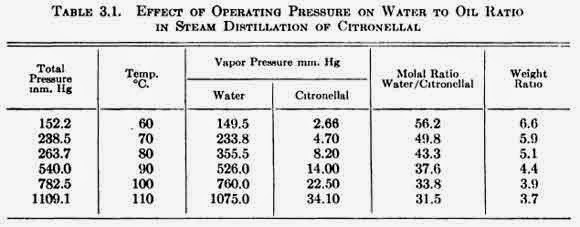
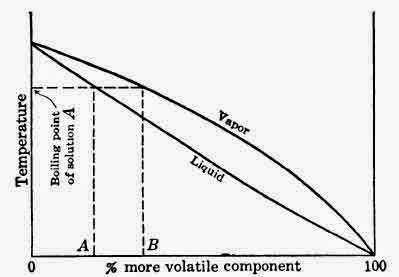
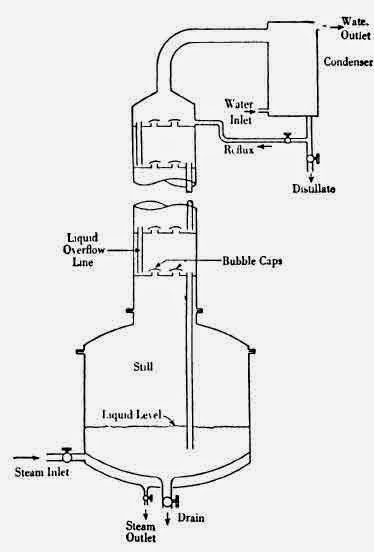
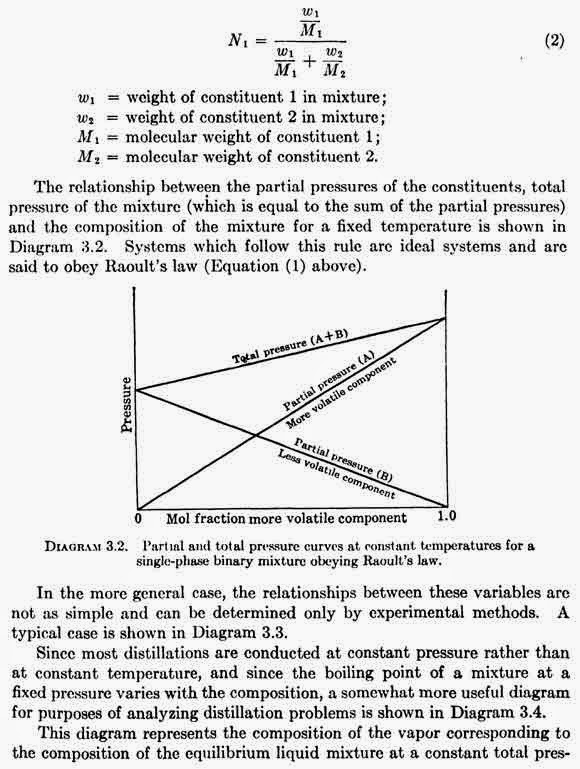

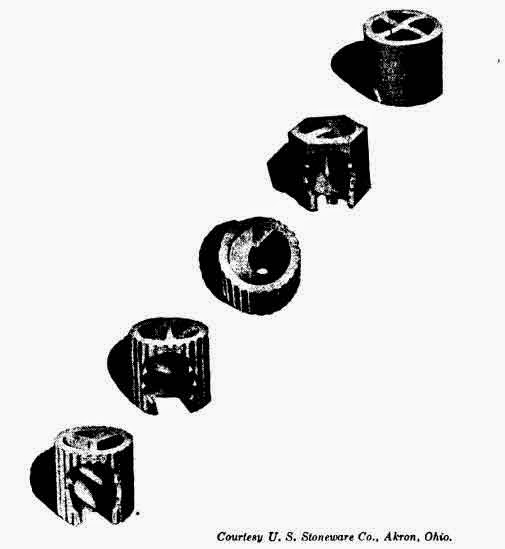
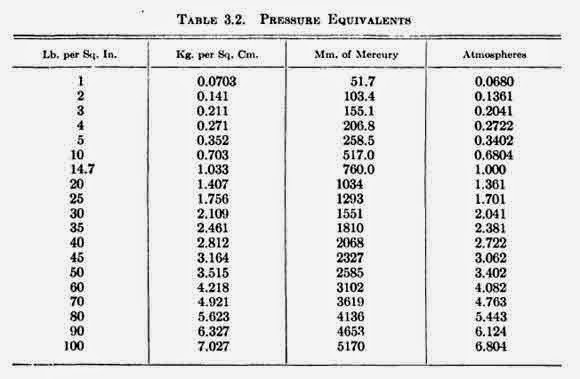

0 Comment:
Post a Comment